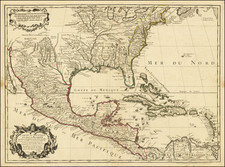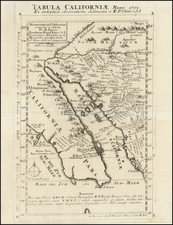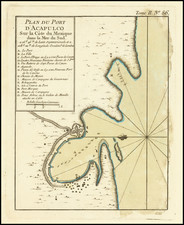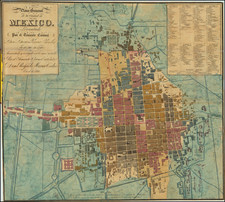Engraved Map of Central Mexico from Bestselling History of the Spanish Conquest
This map was part of one of the most respected histories of the early Spanish encounter with Mexico. he map shows a cross section of New Spain, from just north of the Tropic of Cancer in the north to the city of Antequera, now Oaxaca City, in the south. The maps shows the river systems snaking across the landscape and marks cities with small buildings. The coastlines of both the Gulf of Mexico and the Pacific Ocean are shown. In the center is the large lake upon which Mexico City floats. There are also political boundaries that separate the terrain into five regions.
Historia de la conquista
The map was originally made in the sixteenth century, but was also included in an edition of Antonio de Solís' Historia de la conquista de Mexico, poblacion y progressos de la America septentrional, conocida por el nombre de Nueva España. Solís (1610-86) was a historian and dramatist who served as chronicler of the Indies, or the official historian of the Spanish Empire.
He published the Historia in 1684. It covers the three years from when Cortés was first appointed to command the Spanish invaders until the fall of Tenóchtitlan. Therefore, this map shows part of the Kingdom of New Spain, as it was then called, as the colony did not become a Viceroyalty until 1535.
The book was rapidly translated to French and Italian (1690s) and English (1738) and was reprinted many times in the eighteenth century. It served as the leading history of the Spanish Conquest until the nineteenth century.
This map was part of the new edition of 1704, published in Brussels by Francisco Foppens. Foppens (1685-1761) was a bookseller and publisher from a family of publishers who produced works in Spanish, French, and Latin. It was the first illustration in the book, as evidenced by the folio number, 1, in the upper left corner.









![[Sketch of Río Chacalapa and surrounding hills]](https://storage.googleapis.com/raremaps/img/small/49303ba.jpg)
![Map of Mexico, Central America, and the West Indies [Insets of Bermuda, Sandwich Islands, Jamaica and Panama Railroad]](https://storage.googleapis.com/raremaps/img/small/78369.jpg)



